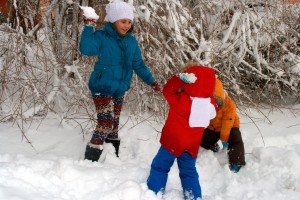Latest Posts
- Have a purpose when backyardingAugust 5 2021
- Study: Time outside alters our microbiomeAugust 4 2021
- Happy National Mutt Day from Mo-MoJuly 27 2021
- New home? Avoid these common mistakes in your yard.July 26 2021
- Infographic: Plan a backyard staycation this summerJuly 22 2021
Categories
Archive
November 27th
Tips for getting your kids outside in the wintertime
Parents and guardians may be tempted to dial back outdoor activities for kids when cold temperatures arrive. But playing outside is good for children, even in the wintertime. TurfMutt offers the following tips to help to make wintertime learning playtime.
Do winter activities that are fun. Weather that adults consider to be “messy” can be a huge canvas for children and their imaginations. Snow balls, snow forts and trees covered in snow offer a wealth of opportunities for children to explore and experiment in our living landscapes.
Encourage exploration. Ask your child to look at how the landscape changes with the seasons. Talk about what happens after leaves fall, when snow arrives, when it’s windy. Also, talk about how these seasonable changes link with basic science about clouds, rainfall, temperature changes and the earth.
Play with them. Get outside in the winter with your children. It’s healthy for both kids and adults to move, even when it’s cold! Have a snowball fight, build a snowman or fort, or go sledding.
Try something new. Try your hands at cross-country skiing, igloo-building, winter hiking, ice fishing, ice skating, snow sculpting, snowshoeing, or something else that your children want to try. It will give them an appreciation of the outdoors in all seasons.
Attend a community festival. There are many community festivals year-round. Winter festivals can be exceptionally fun and offer activities for kids.
Mention how happy it can make them. Even winter sunshine can make kids happy! Literally. Sunlight boosts Vitamin D, which helps regulate emotional and mental moods by increasing serotonin in the brain. Even exposure to the weaker sunlight in the winter can cause this happiness boost.
Tolerate some mess. It’s a given that kids going outside in the snow will often return wet, muddy and messy. Be prepared for wet and cold kids and get them warmed up when they return from playing outside.
Process what they did. Ask kids to share about what they did outdoors. You can ask them to talk, write, or draw out their activities and observations. Did they discover something new? Did something surprise them? What was fun?
Want to learn more about the value of our living landscapes for our health and well-being by visiting SaveLivingLandscapes.com.






